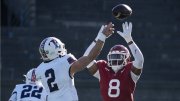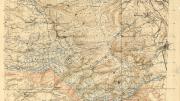It was either sheer inertia or a heartfelt tribute to Tim Murphy that made the voters in the Ivy League’s preseason football poll place two-time defending champion Harvard on top again for 2016. More likely it was the latter; in his 22 seasons on the Crimson sideline, the coach had produced nine titles, plus a startling 15 consecutive seasons with seven or more wins. Moreover, in the previous three seasons Harvard was an omnipotent 28-2. Still, could any program survive the loss through graduation of 13 All-Ivy performers (including the league’s 2015 offensive player of the year, quarterback Scott Hosch ’16) and deserve to be tabbed number one? Wasn’t 2016 a season for lowered expectations?
In the early going, the wisdom of the crowd seemed to be confirmed. Spearheaded by Hosch’s replacement, Joe Viviano ’17, the Crimson got off to a strong start, with easy victories over non-conference foes Rhode Island and Georgetown sandwiched around an impressive road triumph over league rival Brown. The tougher part of the schedule loomed—particularly back-to-back away games with Princeton and Dartmouth—but Harvard at the least would present a formidable hurdle for other aspiring titleholders.
 Harvard Football
Harvard Football
Sign up for Harvard Magazine’s football e-mail and follow the Crimson all season long! Dick Friedman will provide the latest news, game summaries, and insights.
In the preseason, Murphy set about replacing departed members of the class of ’16 who were among the all-time Crimson gridiron greats. On defense, the most glaring holes were those left by an All-Ivy linebacking corps: Matt Koran, Jake Lindsey, and Eric Medes. On the offensive line, the coach needed to find successors to three players who were in NFL camps: Adam Redmond, Cole Toner, and Anthony Fabiano. Gone also were tight end/H-back Ben Braunecker (to the Chicago Bears’ practice squad) and rambling running back Paul Stanton Jr. At the game’s most important position, Hosch’s shrewd decision-making and winning touch were hard-earned intangibles that might be difficult for a neophyte to grasp.
Opposing coaches were shedding no tears: Harvard still had formidable weapons. Most notable was quicksilver receiver/return specialist Justice Shelton-Mosley ’19, last season’s Ivy League rookie of the year. Tight end Anthony Firkser ’17 caught any ball that came his way, then shrugged off would-be tacklers. Running back Semar Smith ’18, while not as brilliant as Stanton, had a similar nose for the end zone. The two holdovers on the offensive line—guard Larry Allen Jr. ’18 and tackle Max Rich ’17—were potent piledrivers and dependable pass-blockers. On the other side of the ball, captain Sean Ahern ’16 anchored the defensive backfield, while the line—seniors James Duberg, Miles McCollum, and Doug Webb, and sophomore Dj Bailey—was close to impregnable against the run.
The major question mark was at quarterback. The 6-foot-5 Viviano, who had seen limited action in 2014, was strong and athletic. Last year he might have supplanted Hosch as the starter but for a preseason foot injury. How would he fare once handed the keys to the offense? It didn’t take long to find out: two minutes and eight seconds of the opening game against Rhode Island, under the lights at Harvard Stadium before 12,167. (Almost all those in attendance were seated on the home side, not unusual these days in the Ivy League.) That was the elapsed time of the Crimson’s scoring drive on its initial possession, a trek that covered 61 yards in a brisk six plays and culminated in a 15-yard touchdown strike from Viviano to Firkser (the first of two scoring hookups between the two). By the end of the first quarter Viviano—with arm, legs, and aplomb—had staked the Crimson to a 21-0 lead.

Against Rhode Island and Brown, 2016 Ivy League rookie of the year Justice Shelton-Mosley ’19 picked up where he left off, amassing 15 receptions, some spectacular.
Photograph courtesy of Harvard Athletic Communications
In the eventual 51-21 rout of the Rams, Viviano played a bit more than three quarters. He was 24-of-32 passing for 290 yards and three touchdowns (and no interceptions). He rushed 10 times for 51 yards and one scintillating touchdown. Above all, he was in command. Murphy, a tough critic, was pleased, especially given that this was Viviano’s most extended outing since his days at Conestoga High School in Berwyn, Pennsylvania. “Joe will get better, but I give him a very high grade,” said the coach afterward.
Viviano’s highlight-reel play came near the end of the first quarter. Ahern had forced a fumble that McCollum recovered on the Rhode Island 22. Runs by Smith and Viviano took the ball down to the Rams’ eight-yard-line. Then Viviano proved a master of escape. Dropping back to pass, he bounced off one Rhode Island rusher and spun away from another. Seeing an alley, he dashed into the end zone. He then spiked the ball—“I was excited,” he explained—incurring a 15-yard penalty (assessed on the ensuing kickoff) for unsportsmanlike conduct. He could be forgiven: it was his first touchdown since his Conestoga days, and had been a long time coming. He recovered his equanimity enough to direct the Crimson to three more scores, the last one set up by a beautiful 36-yard pitch to Shelton-Mosley.
The following Saturday, at sun-splashed Brown Stadium, Viviano hit his stride in the Ivy League opener, a rackety 32-22 Crimson victory. He rushed for a net of 76 yards and two touchdowns on 15 carries. (He was sacked for 22 yards’ worth of losses.) He also completed 17 of 31 passes for 205 yards. Unlike most of today’s quarterbacks, who are primarily passers, Viviano acts almost like an old-fashioned single-wing tailback, passing or running depending on the design of the play or his whim. With his loping stride, he is very hard to stop—and a fearsome weapon for whom opposing defenses must account.
This was the first Harvard game played using an Ivy League experimental rule under which the ball is kicked off from the 40-yard line rather than the 35. The object is to promote safety by means of boots into or out of the end zone, thus curtailing kick returns, the plays on which the most concussions occur. (Another Ivy safety-oriented sanction this season: no hitting during practices.) Against Brown the collateral damage was done to the kick-return career of Shelton-Mosley, who watched two kicks by the Bruins’ strong-legged Jake Wilner sail deep into the end zone for touchbacks; another three were either onside kicks, or squibs that permitted limited runbacks. (Of the 11 kickoffs in the game, four resulted in touchbacks, and only three provided conventional runbacks.) Asked afterward if he was frustrated, Shelton-Mosley said he wasn’t—but the smile on his face showed he had been thinking about it. The safety-conscious Murphy was unmoved. “It’s a good rule,” he said.
It was Murphy’s 221st game on the Harvard sideline, moving him past Joe Restic (1971-93) for most games by a Crimson head coach. Murphy marked the occasion with some trademark trickeration. After Harvard had spotted Brown an early field goal, the Crimson came back with 25 second-period points. After the second of three touchdowns—a seven-yard Viviano bolt up the middle—Harvard lined up for an extra-point kick. But when the ball was snapped to the holder, backup quarterback Cam Tripp ’19, he did not put it down for placekicker Jake McIntyre ’20 to boot but instead picked it up, rolled to his right, and cantered into the end zone for two points, with nary a Bruin within 20 yards.

Tight end/H-back Anthony Firkser ’17 riddled Brown with four receptions for an eye-popping 19.5-yard average. In the season's first three games, Firkser scored four touchdowns, including a 75-yarder against Georgetown.
Photograph courtesy of Harvard Athletic Communications
There were other strong elements. The defensive line stuffed the Brown running attack, limiting the Bruins to 74 yards. Running behind the emerging offensive line, the workhorse Smith gained 89 yards on 22 carries and rumbled for two touchdowns. Linebacker Tanner Lee ’18 and defensive back Wes Ogsbury ’19 made interceptions to blunt Bruin drives. And while you can create kickoff rules that might contain Shelton-Mosley, you can’t stop him, as proven by two plays from scrimmage: a splendiferous, stretching, 34-yard grab of a Viviano bomb and a slick 33-yard reverse, each triggering a score.
The next week, at the Stadium against Georgetown, Harvard played without Shelton-Mosley and Rich, who were held out with minor injuries. They weren’t needed. The Crimson pushed the Hoyas up and down the field, racking up 33 first downs to Georgetown’s nine and winning the total-offense battle 535 yards to 266. Nevertheless, the final score was restrained: Harvard 31, Georgetown 17. This was partly due to two big-play Hoya touchdowns (a 76-yard pass and a 74-yard run), and also to Viviano’s playing only 17 minutes. In that span, however, he completed 15 of 21 pass attempts for 210 yards and three touchdowns, including a 75-yarder to Firkser.
So far, so good. But the meat of the schedule—and, perhaps, health—would determine whether the media had gotten it right.
IN MEMORIAM: Chester M. Pierce ’48, M.D. ’52, died in September after a long illness. He was the first African American to play in a major college football game south of the Mason-Dixon line when he suited up at tackle in 1947 at the University of Virginia over the initial objections of its administrators. (The game passed without incident.) Pierce went on to become a distinguished psychiatrist and educator; the Division of Global Psychiatry at Massachusetts General Hospital is named in his honor. (For more, see “New Faces,” January-February 2011, page 64.)
Tidbits: With the victory over Georgetown, the Crimson is now 14-0 in night games at the Stadium….Under Murphy, Harvard is 18-5 in its Ivy League openers….In geographical representation on the 2016 roster, California leads with 17 players, followed by Texas (16), Georgia (9), Connecticut (8), and Ohio (6).









